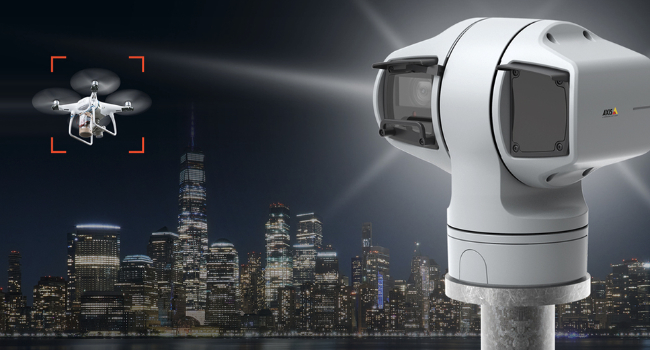
Dedrone Integrates Axis Communications’ Camera to Deliver Multi-Sensor Airspace Security Solution
Dedrone recently announced that it has formed a partnership with Axis Communications to incorporate Axis network cameras into Dedrone’s counterdrone command and control (C2) platform, DedroneTracker. With Axis camera integration, Dedrone is now the first counter-UAS (cUAS) company to provide proven artificial intelligence (AI)- and machine learning (ML)-driven multi-sensor fusion to autonomously detect, track, and identify drones (DTI) with multi-target and multi-camera capability. This airspace security system has already been successfully tested at several locations including Consolidated Edison’s New York City energy facilities.
“ConEdison demands a high level of intelligence and autonomy to ensure the safety, security and business continuity of our NYC Energy Center,” said Scott Gross, Facility Security Officer at ConEdison. “We selected Dedrone because it allows us to integrate our already existing Axis PTZ (pan, tilt, zoom) cameras into DedroneTracker, enabling the PTZs to provide an additional layer of situational awareness for faster drone risk assessment and better payload inspection.”
Gross continued, “Knowing what the drone is, what it’s carrying, and where it is, are all essential to good security strategy. Our successful implementation here in the challenging urban environment of NYC proves the Dedrone and Axis solution can be successful at all our locations throughout the five boroughs and Westchester County.”
Axis’ PTZ cameras, when integrated into Dedrone, offer both wide-area coverage and high-detail footage. The cameras feed into Dedrone’s AI/ML sensor-fusion system, leveraging the DedroneDNA drone library, to accurately differentiate between drones and non-drones and then identify the drone model. Dedrone’s C2 platform, DedroneTracker, continuously and autonomously examines potential targets in the background, then identifies potentially threatening drones, allowing the operator to track and mitigate as needed.
“Our partnership with Axis offers a robust, multi-layered airspace security solution for complex urban environments, such as New York City,” said Ben Wenger, Chief Revenue Officer of Dedrone. “We pride ourselves on the ability of our C2 platform to offer high-quality DTI management while easily integrating with best-in-class technology like Axis’ network cameras to give customers the best solution for every scenario.”
“We are delighted to partner with a leader in the counter-UAS space that understands the need for the highest-quality video data feeding into the Dedrone C2 platform for responsive, intelligent airspace security,” added Drew Pacino, Business Development Manager, Technology Integration Partner Program, Axis Communications. “We share the same goal of creating smarter security solutions for an evolving world, and we’re excited to provide this new use case for our cameras and further integrate our product suite into Dedrone’s cUAS solution.”
Dedrone offers its full end-to-end cUAS solution from DTI to mitigation for every use case. Most recently, the company launched DedroneDefender, its next-generation handheld mitigation system designed for civilian, state, and local law enforcement use in urban environments. Dedrone works across 40 countries, including four of the G-7 nation governments; nine U.S. federal agencies, including the Department of Defense; more than 75 critical infrastructure sites; 20+ airports; and 50 correctional facilities worldwide. The company actively provides drone detection services for some of the most high-profile events around the world and works closely with more than 35 law enforcement agencies.